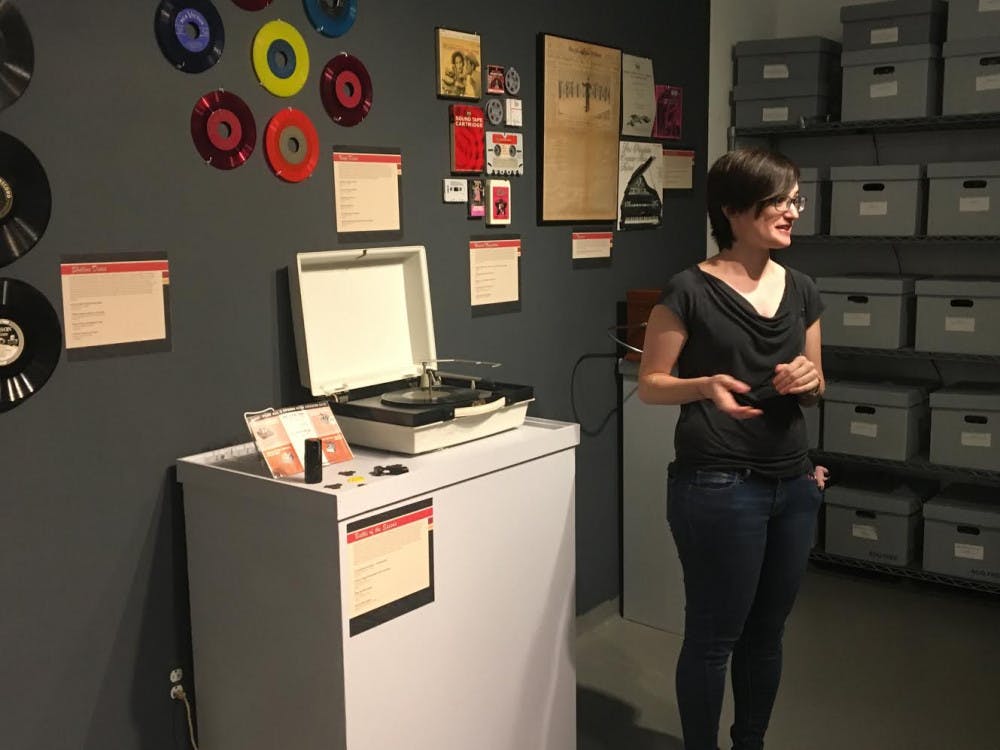By Garrett Cecere
Editor-in-Chief
In a world where technology is constantly evolving, it’s hard to imagine a time when people couldn’t record any music and play it back instantly to enjoy a pleasant melody.
In Roscoe West Hall Room 204, the College’s Sarnoff Collection serves as a reminder of an era when the only ways people could hear music were if they made it to a show or learned to play themselves.
Florencia Pierri, the collection’s curator, led a guided tour of the exhibit on Sunday, Aug. 25, which chronicled 100 years of recorded sound’s history in America, beginning with Thomas Edison’s phonograph and ending with computer synthesizers.
Edison, who had pioneered the phonograph as a foil wrap cylinder, considered Alexander Graham Bell’s recent development of the telephone, as he felt people would benefit from the ability to record their conversations and listen to them.
“Edison thought that the telephone would never, ever catch on in business because there was no way to record the message,” Pierri said.

However, a downside to the phonograph was that recordings were limited to being played back just two times, so Bell helped modify it by adding a wax cylinder.
“It was this wax-covered cylinder that meant that you could record sound with much higher fidelity and you could play it back a couple of times more than the foil wrap cylinder,” Pierri said.
It wasn’t long before people figured out that the invention could go beyond use for work and business, and the recording of music was born. In a time before stereos, tape recorders and MP3 players, people had found a way to hear music and enjoy it over again.
“Before the 1870s, if you wanted to listen to music, well, you had to learn how to play the piano. You had to learn how to sing. You had to learn how to play some sort of instrument,” Pierri explained during the tour. “There was no way of storing music.”
Pierri explained that the process of music entering people’s homes became possible in the 1890s with Regina discs, which were based in New Jersey and could be mass produced due to their sturdy metal material.
Mass production became cheaper due to German inventor Emile Berliner, who eventually teamed up with Elridge Johnson, a machine shop owner in Camden, New Jersey. The result was the inception of the Victor Talking Machine Company. But its successful production of records was short-lived, as radio literally sounded off at a new height during the 1920s and the Radio Corporation of America bought out the company.
After World War II, CBS employee Peter Goldmark had an idea for developing records without using the original material, shellac, which was unavailable because it could only be found in Japan and couldn’t be accessed due to the war. Goldmark’s idea involved polyvinyl chloride, which paved the way for the vinyl record.
According to Pierri, one advantage of vinyl was that grooves on the record could be cut closer together than before, which allowed for more music.
“(The vinyl record) holds a lot; it is long-playing. Columbia (Records) thought that was a great name, so they called this type of record the ‘LP,’” she said.
Pierri went on to discuss magnetic storage of sound, which Danish engineer Valdemar Poulsen pioneered by magnetizing a thin wire and putting sound on it.
“(The wire recorder) is something that I had no idea even existed,” she said. “Even people who are familiar with, say, 8-tracks or early cassettes or reel-to-reel players — a lot of them didn’t realize that the first magnetic storage was a wire.”
Pierri said that the surge of technology in homes during the first 30 years of the 20th century can be attributed to the vacuum tube, which went into many devices, such as wrist watches, hearing aids and the theremin — an experimental instrument known for high-pitched sounds, as well as its use in The Beach Boys’ “Good Vibrations.”
After the development of the theremin, RCA desired to find ways to synthesize music to resemble an orchestra’s sounds, which eventually led to the company wanting its engineers to build a machine that creates music. The result was the electronic music synthesizer.
“(The Sarnoff Collection) does show a lot about how technology has changed a lot in a very relatively short amount of time,” Pierri said, reflecting on the tour. “People went from not being able to record sound. So if you had one sound, it was gone forever. You would hear one music performance just once and that was it … You went from that to being able to artificially synthesize anything you want with computers.”
While the tour took people back in time, Pierri looked ahead to what future innovations may be possible.
“In a hundred years, we went from a tin foil wrap cylinder that could only be played once and poured a very substandard sound to a way to create music without even humans,” she said. “In a hundred years, sound has come an awfully long way, and who knows what it’s going to look like in the next hundred years?”







